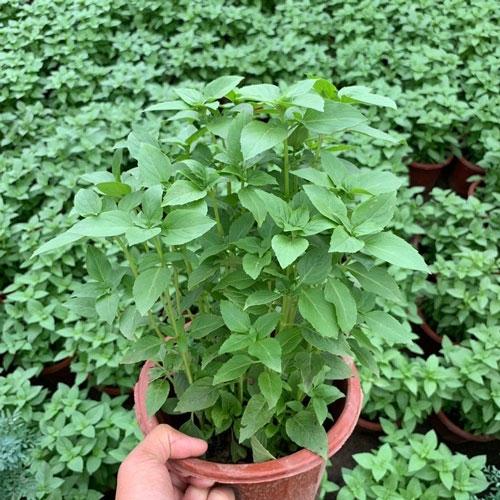Thai Basil Plants (Ocimum Basilicum Horapha) Profile
Written by Iris
Dec 28 2022
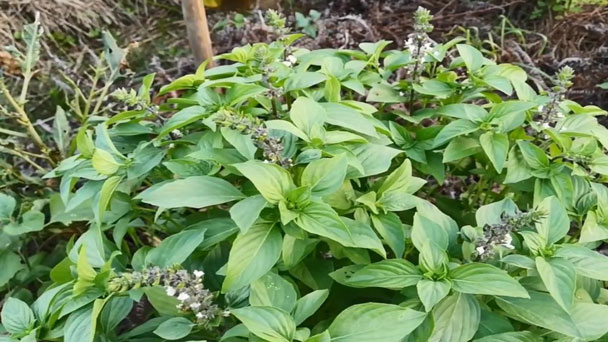
Thai basil (Ocimum basilicum Horapha) has a slight anise flavor and aroma. This warm spice makes Thai basil a perfect addition to your kitchen garden. As the name suggests, it is native to Thailand and is used throughout Southeast Asian cooking. Thai basil also differs in appearance from the more common basil varieties. The plant has small pointed matte leaves that are easily distinguished from the smooth, plump leaves of sweet basil. Thai basil moves a rich purple stem near the top of the plant. The leaves have purple veins that provide an interesting contrast to the dark olive green leaves. When flowering, the plant blossoms with purple bracts and lilac pink petals.
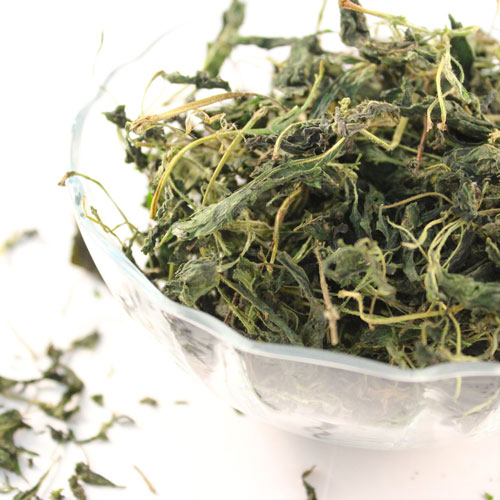
Growing Thai basil plants from seeds is easy and cheap. Seeds are usually very cheap and easily available. Usually, Thai basil plants have relatively low germination rates from their seeds. However, that doesn't mean you can't successfully grow thai basil plants from seed. This means that you may need to do more work and add a few more resources to increase the likelihood of success.
To obtain seed
To avoid such problems, you should check the quality of Thai basil Plants seeds before buying. The best and easiest way is to choose the seed brand with the most online reviews.
sow
Prepare the seed starting mixture by wetting it with warm water. Be careful how much water you put in, as the mixture does not strain too wet. Next comes your container. You can buy seed trays or reuse everyday items that you may already have at home, such as milk or juice cartons.
Any shallow container can be used, but be sure to leave enough drainage holes in it. Fill containers with a moist mixture around the edges and plant seeds on each container. Use four to five seeds per 1.5 x 1.5 inch container.
Grow Thai basil
When finished, cover the seeds with a quarter inch of soil and spray with water, then cover the container with plastic wrap.
Take care of the seed
Keep the seeds in a warm place away from strong and direct sunlight. Remove plastic wrap a few hours a day to let the seeds breathe. Meanwhile, spray the mixture with water to keep the humidity around the seeds as high as possible. After a week or two, your seeds will germinate, and then Thai basil plants can be transferred to different pots.
Thai basil plants Propagation with Stem Cuttings
Growing Thai basil plants from cuttings is more efficient and easier than growing them from seeds. The only downside here is that you need to have a fully fledged thai basil plant to get cuttings from it.
Knowing when to pick branches of Thai basil plants is a fairly simple decision. Wait until a Thai basil plant is at least four inches tall or has at least four sets of leaves on most of its branches. In this case, the cuttings you take will be enough to start taking root and become independent Thai basil plants.
Choose any stalk you want, but make sure it's healthy and strong. Count three or four sets of leaves -- starting at the top -- and make a cut directly under the last leaf.
Remove all the leaves at the bottom of the cut and leave two sets of leaves at the top.
After that, you should submerge the cut in a glass of water. Avoid direct sunlight and make sure to change the water every other day.
After two to three weeks, the cuttings will have developed a well-developed root system. At this point, it will be ready to move to the pot so that it can grow as a plant.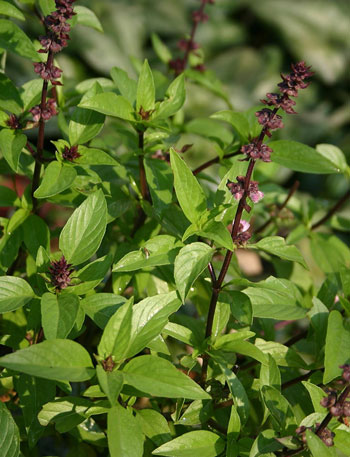
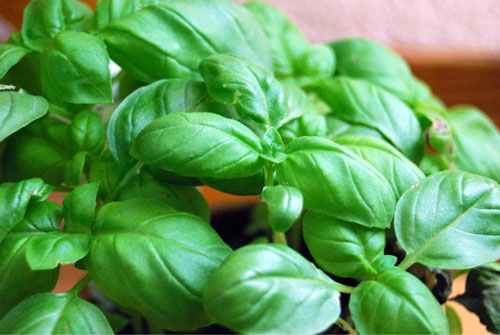
A bunch of basil can be lovely, but you can also mix up other flowers from your garden or even from the market. The high pointy point of the Thai basil flower makes it an excellent filler flower (say five times faster) that can add height and airy elements to a composition.
Smelling oil, similar to peppermint, can have a brain-clearing effect. If you like the smell and find it invigorating, you can make bath salts with basil.
The Thai basil plant is perfect for your kitchen window, not only because it provides quick access to delicious herbs, but also because it works as a fly repellent. In a pinch, you can graze basil leaves and rub oil on your skin as a repellent.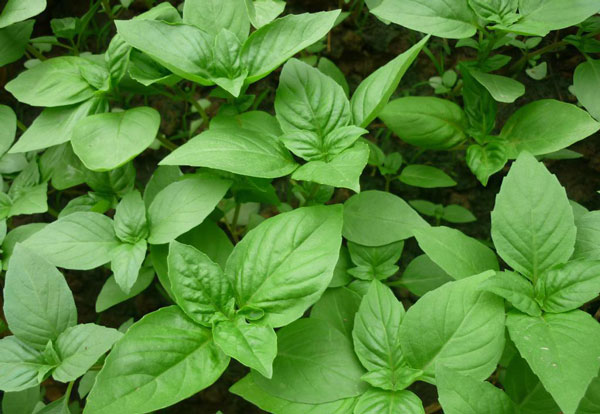
Ocimum basilicum 'Genovese': Commonly referred to as Italian basil, this varietal has large green leaves and a sweet, quintessential basil flavor.
Ocimum basilicum 'Purple': Beloved for its striking rich purple hue, this varietal has pointy leaves and a rich, almost licorice-like flavor.
Ocimum basilicum x citriodorum 'Lemon basil': A hybrid plant, this varietal has thinner, more delicate leaves and is very popular in Asian dishes thanks to its distinct citrus taste.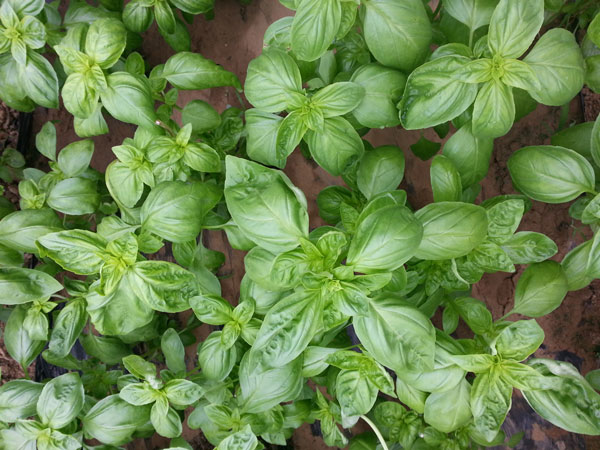
You can harvest as much as you desire from a mature plant. Just be sure not to cut where the stem has become woody or the basil will not continue to produce from that portion of the plant.
Thai basil plants PictureThai basil plants InfoEcological Habits of Thai basil plantsThai basil plants Distribution AreaHow to Grow and Care for Thai basil plantsHow to Grow Thai basil plantsHow to Care for Thai basil plantsLight CareSoil CareWater CareTemperature CareFertilizer CarePruning CareUses of Thai Basil PlantsCulinary Uses for Thai BasilDecorative Uses for Thai BasilMedicinal and Other Uses for Thai BasilVarieties of BasilThai basil plants Common Pests/DiseasesHarvesting Thai Basil PlantsThai Basil Plants Companion Plants
Thai basil plants Picture
Thai basil plants Info
| Scientific Name | Ocimum basilicum Horapha |
| Common Name | Thai basil, oriental basil, Asian basil, licorice basil |
| Plant type | annual herb |
| Height | 40–45cm |
| Flowering | produces spikes with small purple and white flowers |
| Climate | prefers tropical, sub-tropical and warm temperate climates |
| Watering | water regularly, especially during hot dry weather |
| Soil | plant in a soil enriched with compost and aged manure |
Ecological Habits of Thai basil plants
To begin, Thai basil isn’t just one specific plant. Thai basils are a group of cultivars that have a spicier flavor than sweet, with notes of anise or licorice. thai basil plants has smaller leaves that often have serrated edges, as well as a stronger flavor. On top of being bolder in flavor all around, the leaves and flowers also have a hint of licorice or anise flavor that sweet and holy basil varieties lack. The stem of Thai basil plants is usually purple or red, and the flowers are also purple or red.Thai basil plants Distribution Area
Native to the tropical regions of southeast Asia, Thai basil prefers full sun, warm conditions similar to the sweet basil commonly grown in gardens and kitchen windowsills. Thai basil plants grow well outside when they can take advantage of the hot summertime temperatures and long days.
How to Grow and Care for Thai basil plants
How to Grow Thai basil plants
Thai basil plants Propagation with SeedsGrowing Thai basil plants from seeds is easy and cheap. Seeds are usually very cheap and easily available. Usually, Thai basil plants have relatively low germination rates from their seeds. However, that doesn't mean you can't successfully grow thai basil plants from seed. This means that you may need to do more work and add a few more resources to increase the likelihood of success.
To obtain seed
To avoid such problems, you should check the quality of Thai basil Plants seeds before buying. The best and easiest way is to choose the seed brand with the most online reviews.
sow
Prepare the seed starting mixture by wetting it with warm water. Be careful how much water you put in, as the mixture does not strain too wet. Next comes your container. You can buy seed trays or reuse everyday items that you may already have at home, such as milk or juice cartons.
Any shallow container can be used, but be sure to leave enough drainage holes in it. Fill containers with a moist mixture around the edges and plant seeds on each container. Use four to five seeds per 1.5 x 1.5 inch container.
Grow Thai basil
When finished, cover the seeds with a quarter inch of soil and spray with water, then cover the container with plastic wrap.
Take care of the seed
Keep the seeds in a warm place away from strong and direct sunlight. Remove plastic wrap a few hours a day to let the seeds breathe. Meanwhile, spray the mixture with water to keep the humidity around the seeds as high as possible. After a week or two, your seeds will germinate, and then Thai basil plants can be transferred to different pots.
Thai basil plants Propagation with Stem Cuttings
Growing Thai basil plants from cuttings is more efficient and easier than growing them from seeds. The only downside here is that you need to have a fully fledged thai basil plant to get cuttings from it.
Knowing when to pick branches of Thai basil plants is a fairly simple decision. Wait until a Thai basil plant is at least four inches tall or has at least four sets of leaves on most of its branches. In this case, the cuttings you take will be enough to start taking root and become independent Thai basil plants.
Choose any stalk you want, but make sure it's healthy and strong. Count three or four sets of leaves -- starting at the top -- and make a cut directly under the last leaf.
Remove all the leaves at the bottom of the cut and leave two sets of leaves at the top.
After that, you should submerge the cut in a glass of water. Avoid direct sunlight and make sure to change the water every other day.
After two to three weeks, the cuttings will have developed a well-developed root system. At this point, it will be ready to move to the pot so that it can grow as a plant.

How to Care for Thai basil plants
Light Care
Light is perhaps the most controversial and complex issue when growing thai basil plants indoors. Even more challenging, mature Thai basil plants need long exposure to direct sunlight to bloom.Soil Care
Thai basil plants prefer a moist but well-drained soil mixture. For best results, modify the potting soil with a little organic compost before planting Thai basil plants indoors. Also, make sure to choose a pot for your Thai basil plants that has plenty of drain holes at the bottom so the soil doesn't become wet or waterlogged.Water Care
There is a big difference between watering Thai basil plants in pots and watering them in the garden, and this is where all mistakes can happen. Overwatering and watering are two very common problems when growing Thai basil plants. If the temperature is not very high, you cannot water Thai basil plants every day, whereas in hot weather you may need to water Thai basil plants twice a day. The best way to know when to water Thai basil plants is to simply monitor the soil every day.- Read More: How Often Should You Water Basil
Temperature Care
Because you grow Thai basil plants indoors, you need to be extra careful about fluctuating temperature and humidity levels around the plants. Daytime temperatures of around 75°F (24°C) are best for Thai basil plants. The temperature should drop to around 68°F (20°C) overnight.Fertilizer Care
If you've previously modified your soil with organic compost, chances are your Thai basil plants don't need additional nutrients. However, if you notice that your plants are not growing much, you can feed your Thai basil plants once a month using weak liquid fertilizer.Pruning Care
Harvest regularly to promote compact growth. An annual herb, plants should be cut down at the end of the growing season. The leaves can be dried for use throughout the year.
Uses of Thai Basil Plants
Culinary Uses for Thai Basil
Culinary use is by far the most common use of the herb. In fact, that's why I grow this unique variety. The fennel, warm spice flavors we discussed make it an excellent complement to curries, spicy dishes and meat entrees. Thai basil, in particular, is more resistant to heat, making it the best choice for recipes that require longer cooking at higher temperatures. Thai basil also works well with mint and coriander! Wherever you see these herbs, try Thai basil. Thai basil and mint iced tea are a pick-me-up in the summer.Decorative Uses for Thai Basil
The aroma of Thai basil and its distinctive purple stems/flowers make it an excellent choice for decorative purposes. Simply cut a flowering piece from the plant long enough to fit into a container of your choice. Remove all leaves below the waterline and place them in a container or a glass of water. If replaced with water and no leaves, the cuttings will last for weeks.A bunch of basil can be lovely, but you can also mix up other flowers from your garden or even from the market. The high pointy point of the Thai basil flower makes it an excellent filler flower (say five times faster) that can add height and airy elements to a composition.
Medicinal and Other Uses for Thai Basil
In the past, basil was used to calm the stomach and for other medicinal purposes. Even if it's not a doctor's order, all kinds of basil, including Thai basil, are great digestive AIDS. Adding herbs to dishes is the easiest way to reap the benefits. However, you can use it in your tea as suggested earlier.Smelling oil, similar to peppermint, can have a brain-clearing effect. If you like the smell and find it invigorating, you can make bath salts with basil.
The Thai basil plant is perfect for your kitchen window, not only because it provides quick access to delicious herbs, but also because it works as a fly repellent. In a pinch, you can graze basil leaves and rub oil on your skin as a repellent.

Varieties of Basil
There are dozens of types of basil, each of which has its own unique flavor and attributes. Some of the most popular varietals suited to indoor growing include:Ocimum basilicum 'Genovese': Commonly referred to as Italian basil, this varietal has large green leaves and a sweet, quintessential basil flavor.
Ocimum basilicum 'Purple': Beloved for its striking rich purple hue, this varietal has pointy leaves and a rich, almost licorice-like flavor.
Ocimum basilicum x citriodorum 'Lemon basil': A hybrid plant, this varietal has thinner, more delicate leaves and is very popular in Asian dishes thanks to its distinct citrus taste.
Thai basil plants Common Pests/Diseases
Snails and slugs can attack young Thai basil plants. Use organic snail pellets or use snail and slug traps for protection. Avoid overhead watering, especially during the day. If aphids are a problem, spray with suitable organic insecticides to prevent further damage.
Harvesting Thai Basil Plants
When it comes to basil, pinching is actually helpful to the plant. Pinching off the top sets of leaves on a basil plants early and often helps encourage growth. Doing so will encourage the plant to grow bushy rather than leggy and long. Pinching it back also allows the plant to use its energy to produce abundant flavorful leaves rather than long stems.You can harvest as much as you desire from a mature plant. Just be sure not to cut where the stem has become woody or the basil will not continue to produce from that portion of the plant.
Thai Basil Plants Companion Plants
- Chamomile
- Tomato
- Oregano
Latest Updated
- Benefits of Bugleweed - 7 Science-backed Health Benefits
- Bugleweed Dangers & Side Effects - Is It Poisonous?
- How to Plant Evergreen Trees - What You Should Know
- When to Plant Evergreens - Grow Guide for Evergreen Trees
- 12 Wonderful Evergreen Shrubs for Your Garden
- 12 Popular Evergreen Plants with Pictures for Beginners
- When And How To Prune A Lilac Bush Like a Pro
- How to Grow & Care for Lilac Vine (Hardenbergia Violacea)
- Japanese Lilac Tree (Syringa Reticulata) Care & Propagation Guide
- Shumard Oak Pros and Cons - What to Know
Popular Articles
- Winter maintenance of Antirrhinum Majus
- How to Grow Terminalia Mantaly Tree
- How to Grow and Care for Crossostephium Chinense
- How to grow Antirrhinum Majus in spring
- Peristeria Elata (Dove Orchid) Profile: Info & Care Guide
- Underwatered Snake Plant (Sansevieria Trifasciata) - Signs And How To Fix
- How to Care for Brazilian Jasmine Plant (Mandevilla Sanderi)
- How to Grow & Care for Graptopetalum Purple Delight in Summer
- Rosa Chinensis (China Rose): Plant Growing & Care Tips
- How to Care for Baby Sun Rose (Aptenia Cordifolia)
